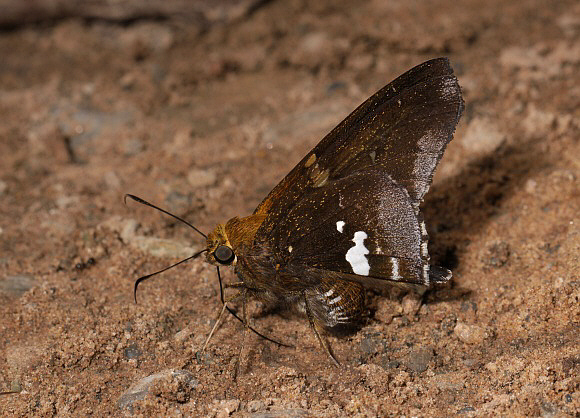
Introduction
The Hesperiidae comprises of 5 subfamilies – Hesperiinae, Heteropterinae, Pyrrhopyginae, Pyrginae and Megathyminae. The Pyrgini tribe usually rest and bask with their wings fully outspread, but the Eudamini usually hold their wings either fully or partially raised while feeding.
The tribe includes 44 genera in the neotropical region, amongst which are the Long-tailed Skippers Urbanus, Chioides and Aguna; and other familiar genera as Phocides, Autochton and Astraptes.
There are 18 described species in the genus Epargyreus, all featuring one or more large, irregularly shaped white “silver-drop” spots on the underside hindwings. The shape and size of the spots varies according to species, and also varies somewhat within each species, so it can be difficult to identify these butterflies without killing them to dissect the genitalia. The identification of the illustrated butterfly should be regarded as tentative.
There are at least 6 Epargyreus species found in Peru. The known distribution of exadeus stretches from Mexico to Brazil.
Habitats
Epargyreus exadeus is found in rainforest and cloudforest habitats at altitudes between 200-1800m.
Lifecycle
To be completed.

Adult behaviour
These butterflies are usually encountered singly. In common with other Eudamini, the males of this species are attracted to bird droppings. They are also strongly attracted to mineral-rich moisture, and can be seen drinking at damp sand, stone walls and rocky overhangs. On hot sunny days they can be found extracting moisture from these substrates with their proboscises, filtering out sodium and other minerals, and curving their abdomen forward to squirt the filtered water out from their anus onto the ground beneath their feet. They use the filtered water to dissolve further minerals from the soil, which they re-imbibe. This “filter-feeding” is practised by the males of many butterfly species, but is most commonly observed in skippers and in swallowtails.
The flight is powerful, with the butterflies circling and zig-zagging very rapidly just above the surface of the ground, prior to settling. They have a very nervous disposition, but eventually become so engrossed in feeding that they can be approached and photographed.
